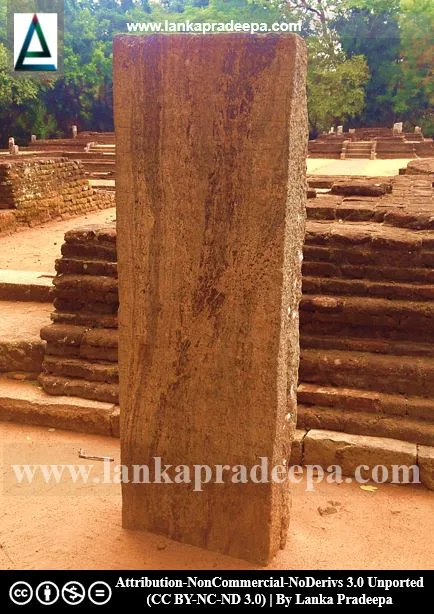 Panduwasnuwara Tamil Slab Inscription (Sinhala: පඬුවස්නුවර දෙමළ පුවරු ලිපිය) is one of the Tamil inscriptions in Sri Lanka. It was discovered in 1951, by Senarath Paranavitana, the then Archaeological Commissioner. Presently, it is erected in front of an ancient Buddhist temple located south of the Panduwasnuwara Citadel.
Panduwasnuwara Tamil Slab Inscription (Sinhala: පඬුවස්නුවර දෙමළ පුවරු ලිපිය) is one of the Tamil inscriptions in Sri Lanka. It was discovered in 1951, by Senarath Paranavitana, the then Archaeological Commissioner. Presently, it is erected in front of an ancient Buddhist temple located south of the Panduwasnuwara Citadel.
Panduwasnuwara is a ruined city situated in Kurunegala District. During the medieval period this city was known as Parakramapura, the capital of the principality of Dakkhinadesa founded by King Parakramabahu I [(1153-1186 A.D.) Nicholas, 1963].
This inscription consists of 22 lines and has been written in the Tamil language with the Tamil scripts of about the 12th century A.D. Several words are written in both Tamil and Grantha characters. A few Sinhalese words are also identified in the inscription (Pillay, 1960).
The inscription says that it was erected in the fifth year of Nissankamalla's (1187-1196 A.D.) reign. Which suggests that this was placed here in the year of 1191 A.D. or 1192 A.D. (Pillay, 1960). It records the benevolent deeds done by a commander named Kulantey Matimana Panjara. This commander is identified with Lak Vijayasinha, the person who is mentioned in the slab inscription of Nissankamalla in Polonnaruwa. According to the record, the commander Kulantey has built a monastery for monks, an alms hall, a Stupa (Cayittam) and a Pirivena named Parakrama Adhikari near the Bodhi tree in Sri-Pura town.
Panduwasnuwara Slab Inscription (Tamil)
Reign: Nissanka Malla (1187-1196 A.D.)
Period: 12th century A.D. Script: Medieval Tamil Language: Medieval Tamil
Transcript: Tennilankaik kon Parakramabahu Niccanka Mallar ..........>>
Translation: Parakramabahu Niccanka Mallar, the king of South Ceylon ..........>>
Reference: Pillay, 1960.
 .
.
References
1) Nicholas, C. W., 1963. Historical topography of ancient and medieval Ceylon. Journal of the Ceylon Branch of the Royal Asiatic
Society, New Series (Vol VI). Special Number: Colombo. Royal Asiatic
Society (Ceylon Branch). p.104.
2) Pillay, K. K., 1960. A Tamil inscription from Panduvasnuvara: University of Ceylon Review (Vol: XVIII Nos 3 & 4). Ceylon University Press. pp. 157-162.
2) Pillay, K. K., 1960. A Tamil inscription from Panduvasnuvara: University of Ceylon Review (Vol: XVIII Nos 3 & 4). Ceylon University Press. pp. 157-162.
Explore Other Nearby Attractions
Location Map (Google)
This page was last updated on 7 June 2023

